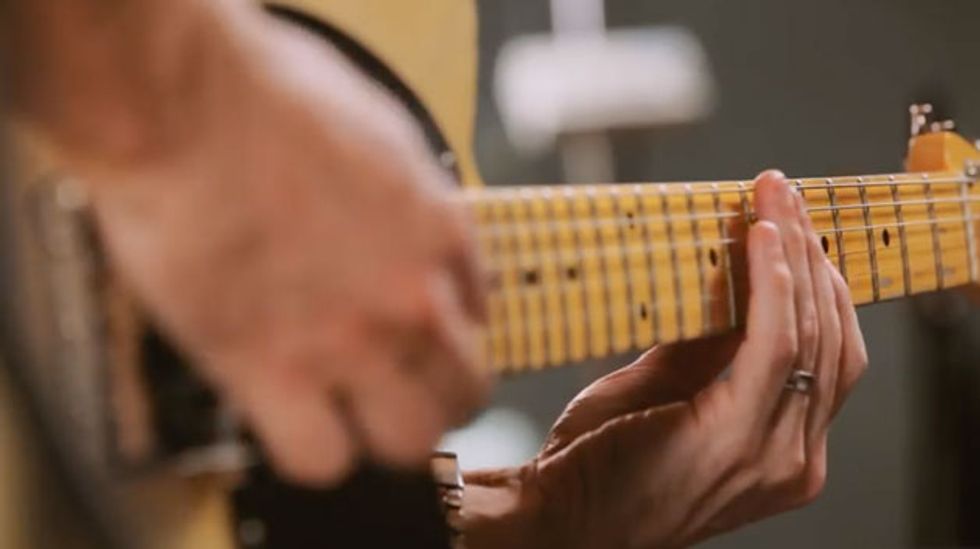Chops: Advanced
Theory: Intermediate
Lesson Overview:
• Discover how to phrase in odd-meter grooves.
• Learn minor 13 voicings in the style of Prince.
• Use hybrid picking to create syncopated licks.
Click here to download a printable PDF of this lesson's notation.
I’ve noticed that some of my favorite guitarists, no matter what genre they might play, all have a knack for seamlessly blending chords and single-note lines. Take a listen to rockers like Eddie Van Halen or Ty Tabor, jazz-rock guru Wayne Krantz, or the late, great gospel/soul maestro Chalmers “Spanky” Alford. It’s serious harmonic ear candy.
These kinds of rhythm parts can fill up just the right amount of space in the sonic and compositional mix. They’re especially useful in a trio context. I’ve heard a guy named Jimi from Seattle was supposed to be pretty good in this regard. In this lesson, I’m going to lay out five different vibes that range from neo-soul and funk to fusion and hard rock. Each one of these examples will hopefully open your fingers and ears to some new ways to walk the line between rhythm and lead.
Let’s start with Ex. 1, an odd-meter groove featuring open-string chord voicings, low-E string riffing, and a twangy hammer-on/pull-off lick. The motif is split into two time signatures: 7/4 and 4/4. The chord progression essentially is Dm9–G13, but uses the open 2nd and 1st strings to give each chord a more unique timbre, à la Krantz.
Use hybrid picking for the phrase in measures three and six. The pick will land well on the 4th string while your middle finger plucks the 3rd string. Also, notice that when the whole motif repeats in measure four, the first chord of the phrase is displaced by a 16th-note rather than starting right on the downbeat.
Click here for Ex. 1
It’d be almost impossible for me to write a column about rhythm guitar without throwing in a good ol’ Minneapolis-style groove. If you’re not already aware of my love for Prince, well, Ex. 2 should make it more apparent. We’re in the key of B minor with a four-on-the-floor beat. Starting with a B5 power chord, the chord shapes feature a mix of minor and major triads, plus the classic funk minor 13 and minor 7 voicings on the top strings. Make sure that all the chord slides are right in the pocket and keep your right hand loose—almost like you’re playing a shaker.
Click here for Ex. 2
Ex. 3 is a slinky R&B-style groove, perhaps of the early-’90s variety, with some chordal maneuvers that were typical of the genre. The overall vibe is based on chord slides into single-note lines. YouTube has plenty of videos of Mr. Alford (and his many disciples) that showcase both simple and highly advanced examples of this technique. Also, notice that many of the triad shapes in this example can function as major or minor chords, depending on the bass note.
Click here for Ex. 3
It’s time to do a little heavy lifting. I mentioned Ty Tabor of King’s X earlier, and that’s because King’s X is a huge influence on my riff writing and overall groove concept. They’ve got a way of making heavy music swing like nobody’s business. Maybe it’s a Texas thing? I don’t know, ask Pantera. Anyway, Ex. 4 is a “Dogman”-styled riff based around C#7#9. Crank up a nice crunch tone and focus on the right-hand muting to make it clean.
Click here for Ex. 4
Ex. 5 is just kinda weird. Again, here are more shuffles implied on top of straight-up funk beats. The hi-hat in the backing track will help you get the feel of the shuffle sections. Consider using hybrid picking for the double-stops and chord shapes in measures five, six, and seven, as well as the triads that restart the motif after the final legato run.

















